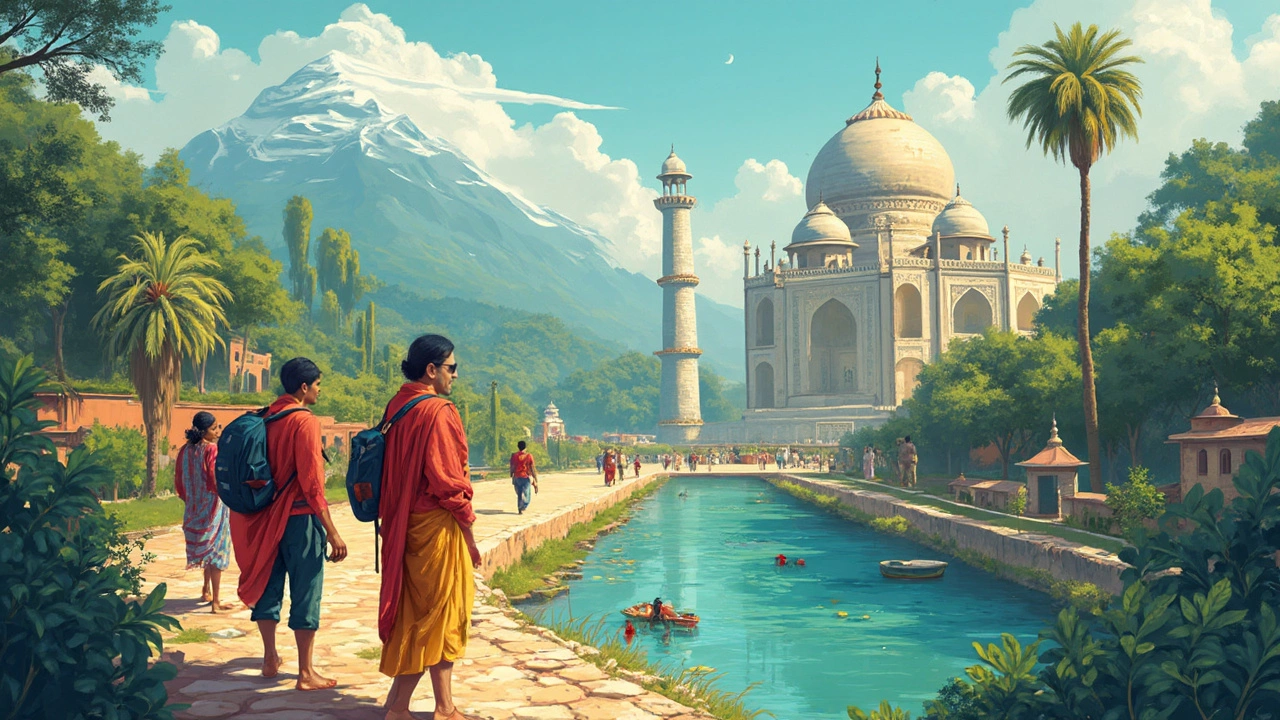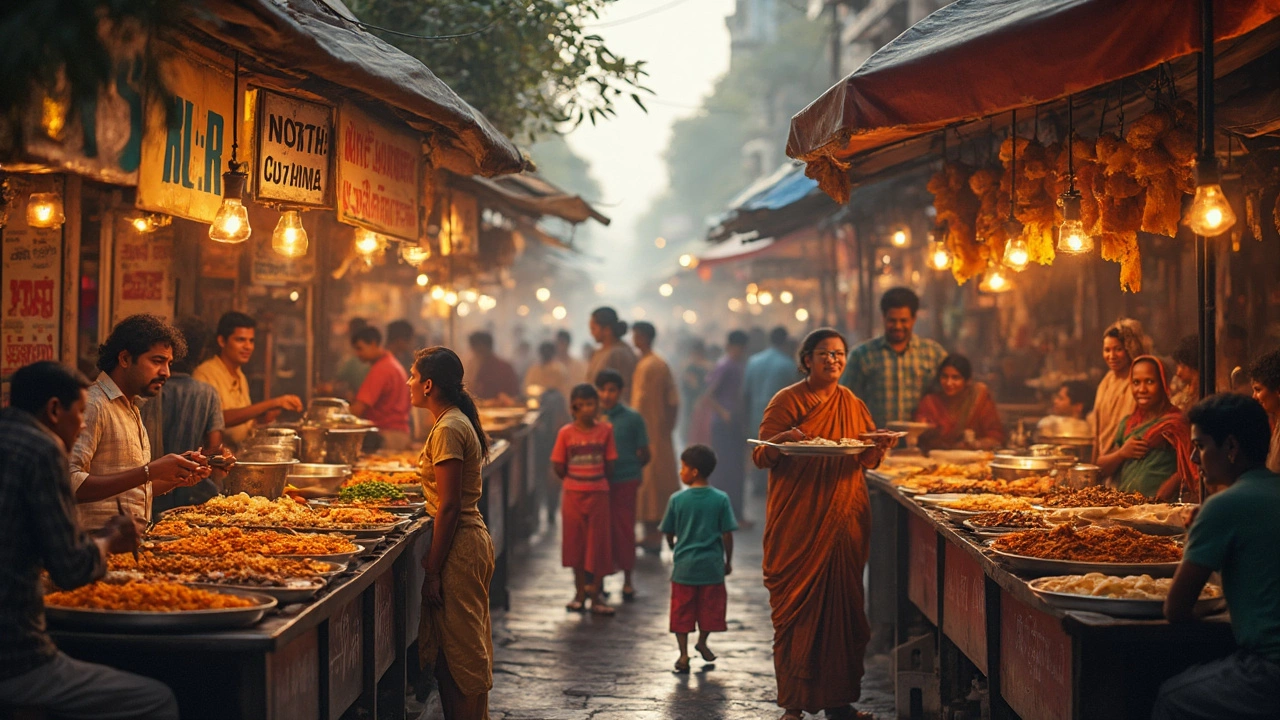North India vs South India: Which is Better for Tourists?
 Jun, 4 2025
Jun, 4 2025
You see the Taj Mahal on a postcard and dream of standing right in front of it. Or maybe you imagine chill beaches and coconut trees in the distance. North and South India are so different, picking between them feels like flipping a coin.
North India is where most buckets lists get checked off: think Jaipur’s pink palaces, snowy mountains in Himachal, Delhi’s wild energy, and the spiritual pull of Varanasi. Tourists from all over the world flock here for the big sights, busy markets, and street food stalls that don’t quit even at midnight. If you crave action and people-watching, North India never stops moving.
- What’s Unique About North India?
- Why Do People Love South India?
- Clear Differences—Weather, Food, and Culture
- Quick Tips to Help You Decide
What’s Unique About North India?
North India grabs attention for big, bold experiences. You’ve got the highest mountains in the world—think the Himalayas, which stretch across Himachal Pradesh, Uttarakhand, Jammu & Kashmir, and Ladakh. In fact, Ladakh’s Pangong Lake sits at over 4,000 meters above sea level and gets a steady rush of Instagrammers every summer.
When it comes to history and culture, this region is stacked. There’s the north india tourism crowd-magnet Taj Mahal in Agra, plus massive forts and palaces in Rajasthan, like Jaipur’s Amber Fort and Udaipur’s Lake Palace. Delhi crams in thousands of years of history, from the Red Fort to Qutub Minar. People who love ancient sites and city life will find plenty to explore.
The spiritual side stands out, too. Varanasi, one of the world’s oldest cities, draws travelers who want to see ancient rituals and stunning riverside ceremonies on the Ganges. Then there’s Amritsar’s Golden Temple, which serves 100,000 free meals every single day—open to anyone, no questions asked.
- Street food is next level: North India’s chaat (think spicy snacks), Delhi’s parathas, and Lucknow’s kebabs keep foodies busy.
- Shopping feels like an adventure, with huge bazaars selling everything from colorful fabric to handcrafted jewelry.
- Winter can get freezing, especially above Delhi—bring layers if you’re coming between December and February. Summers hit 45°C easily, but up in the mountains, it’s always cooler.
| Spot | State | Annual Visitors (approx.) |
|---|---|---|
| Taj Mahal | Uttar Pradesh | 7 Million |
| Golden Temple | Punjab | 6 Million |
| Jaipur City Palace | Rajasthan | 2 Million |
| Manali & Shimla | Himachal Pradesh | 5 Million |
| Varanasi Ghats | Uttar Pradesh | 1.5 Million |
Getting around is easy with a combo of high-speed trains and local flights. If you like your travel busy, buzzing, and full of surprises, North India will keep you on your toes.
Why Do People Love South India?
If you’re after a totally different vibe from North India, South India has its own thing going on. The first thing most people notice—everything feels more chilled out. Cities like Kochi, Mysore, and Pondicherry won’t smack you in the face with chaos. Instead, you’ll find quieter streets and a much slower pace.
What really draws travelers in? Beaches and backwaters, for starters. Kerala is famous for its houseboat cruises in Alleppey, where you cruise narrow canals surrounded by green palms. Goa’s beaches aren’t exactly a secret, but if you want classic surf towns or hidden coves, check out Gokarna or Varkala down south.
- Coffee addicts, you’re in luck—most of India’s coffee comes from plantations in Coorg and Chikmagalur. You can stay in a coffee estate and sip your way through the morning.
- Food here is a whole different story: dosas, idlis, coconut curries, and fresh seafood rule. If North India serves fiery curries and tandoori dishes, South India wins with lighter, tangier flavors.
- Temples are works of art. The Meenakshi Temple in Madurai and the ancient ruins at Hampi blow people away. The architecture here is more detailed, with colors you can’t miss.
South India is also cleaner than a lot of travelers expect, and you see less air pollution, especially outside big cities. If you worry about the summer heat, this region has hill stations like Munnar and Ooty—think cool weather, tea gardens, and misty views.
Check out this quick comparison of key travel highlights for South India vs the north:
| Feature | South India | North India |
|---|---|---|
| Main Attraction | Backwaters, Beaches, Temples | Taj Mahal, Mountains, Forts |
| Top Food | Dosa, Idli, Coconut Curry | Butter Chicken, Biryani, Tandoori |
| Weather | Tropical, Less Cold | Hot Summers, Freezing Winters |
| Best Season | October-March | October-March |
There’s a reason why backpackers, families, and even honeymooners keep picking South India. It just keeps things simple—and even the crowds feel more relaxed. If you want a break from the wild pace up north, south india travel can feel like a much-needed reset.

Clear Differences—Weather, Food, and Culture
If you think all of India is the same, the first train ride between North and South will blow your mind. Seriously, everything changes—what people wear, what’s on your plate, and even how hot or cool you feel.
north india tourism draws people in with dramatic weather swings. In the North, you get freezing winters in places like Kashmir and searing heatwaves in Delhi and Rajasthan. Summer can push over 45°C (113°F) in the plains. Want snow? Hit the Himalayas from December to February. Meanwhile, South India is less extreme. It leans tropical—expect sweaty summers and a heavy monsoon season, especially on the west coast. Cities like Kochi and Chennai rarely get chilly, and you can hit the beaches almost year-round.
Now food—North is famous for butter chicken, naan, and biryani loaded with dried fruit and nuts. It’s all about wheat. In South India, rice rules—think dosa, sambar, and coconut chutneys. South Indian meals are usually spicier and people eat with their hands right off banana leaves in many restaurants. You can literally taste the difference in every bite.
| Category | North India | South India |
|---|---|---|
| Weather | Cold winters, hot summers, snow in mountains | Warm all year, heavy monsoons, humid |
| Popular Foods | Naan, butter chicken, rich gravies | Dosa, idli, spicy sambar, coconut |
| Languages | Hindi, Punjabi, Urdu, others | Tamil, Kannada, Telugu, Malayalam |
| Dress | Kurtas, sarees, turbans | Lungi, sarees, light cotton wear |
Culturally, North India has more hustle and crowded city life—think of packed bazaars and grand festivals like Diwali and Holi. South India is a bit slower and more laid-back. The temples here are next-level impressive (look up Meenakshi Temple), and classical art like Bharatanatyam dance is everywhere. Both regions love a big celebration, just with different flavors and tunes.
So, when planning your trip, don’t just flip a coin. Think about what kind of weather you can handle, what food excites you most, and whether you want to navigate massive markets or chill at laid-back beachside cafes. The differences are big, and what fits your style is totally your call.
Quick Tips to Help You Decide
Still can’t pick between North and South? Here’s what actually matters when planning your trip.
- north india tourism is best if you want to hit famous landmarks. North India is stacked with UNESCO sites—Taj Mahal, Qutub Minar, Red Fort, and Jaipur’s forts get all the Instagram love. If ticking off world-famous sights is your thing, the north is your playground.
- Weather can totally change your plans. North India has extremes: freezing winter in December–January and intense heat from April to June. South India, with its tropical vibe, stays fairly warm year-round. Monsoon season (June–September) dumps heavy rain on the south, so plan accordingly if you hate wet shoes.
- Food is a huge part of the travel experience. North India brings spicy curries, butter chicken, naan, chaat, and tandoor. South India hits you with dosa, idli, sambar, coconut-heavy stews, and lots of rice. Each region’s food is totally different, but both are cheap to try everywhere.
- If you want mountains and desert, go north: think the Himalayas or Rajasthan's Thar Desert. If you’re into beaches, coffee plantations, or lush green hill stations, book it south—Kerala and Karnataka’s coastlines are unbeatable.
- Budget-wise, traveler costs are similar in both regions if you stick to local food and transport. Tourist hotspots in North India sometimes bump up prices, especially around Agra and Jaipur. South India is a little easier on the wallet in smaller towns and hill stations.
Pick North India for history, monuments, and cultural “wow” moments. Go South if you want chill beaches, lots of nature, and lighter crowds. If you’re up for adventure, nothing’s stopping you from mixing both in one epic tour—plenty of trains and flights connect the regions fast.